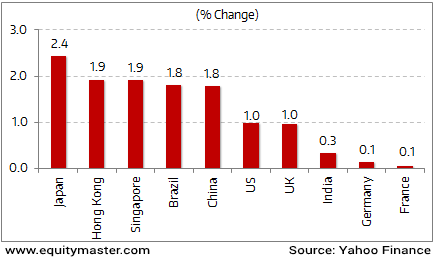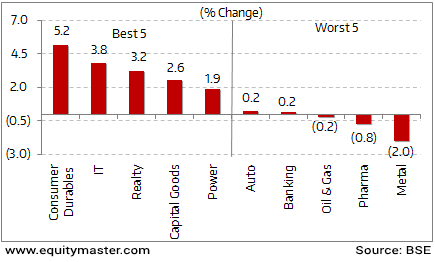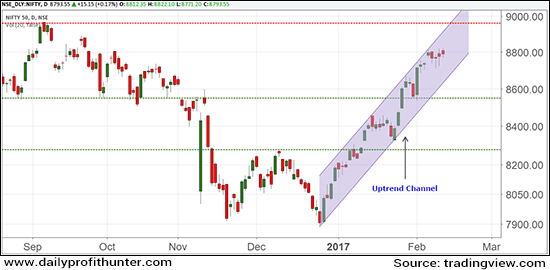India's Third Giant Leap
This Could be One of the Biggest Opportunities for Investors
- Home
- Todays Market
- Indian Stock Market News February 11, 2017
Global Markets Close the Week on a Positive Note Sat, 11 Feb RoundUp
Most of the global markets ended the week on a positive note. Major Asian indices like Japan (up 2.4%) and Hong Kong (up 1.9%) were the top gainers for the week. While European markets closed on a flattish note. A host of strong economic data across various countries and hopes that US President Donald Trump would take measures that will boost US economic growth helped to support global indices.
US Markets (up 1%) continue to see new highs, as Donald Trump said he would make a major tax announcement in a few weeks. Trump is looking forward to lower the tax burden on corporates. The US markets have rallied by almost 8% since Trump's victory in the elections. The US indices have surged, as he promises not only to lower corporate taxes, but also reduce regulations and increase infrastructure spending.
This has elated most investors. The investors are now looking for details about Trump's policy agenda; this will too impact the market direction going forward. The rally in the US market was also boosted on the back of recent economic data and reports that indicate the US economy might be on the upswing early in the year.
As Trump promises for better corporate tax structure, various Asian markets too surged during the week gone by. Major European stocks closed the week on a flattish note, but have closed at two week high levels. A raft of better than expected UK data too boosted the rally in the British indices.
Back home, the Indian indices closed higher by 0.3% for the week. Contrary to strong expectations, the Reserve Bank of India, maintained status quo in interest rates once again. The markets had still pinned hopes on repo rate cuts to kick start the economic growth engine amidst a benign inflationary environment.
Just Released: Multibagger Stocks Guide
(2017 Edition)
In this report, we reveal four proven strategies to picking multibagger stocks.
Well over a million copies of this report have already been claimed over the years.
Go ahead, grab your copy today. It's Free.

Key World Markets During the Week

On the sectoral indices front, consumer durables and IT stocks led the gainers this week. On the other hand, stocks from metal and pharma witnessed selling pressure.
BSE Indices During the Week

Now let us discuss some key economic and industry developments during the week gone by.
Contrary to strong expectations, the Reserve Bank of India had kept interest rates unchanged in the last monetary policy in December 2016. However, banks undertook sharp cuts in marginal cost of lending rates (MCLR) at the start of 2017 after loan subsidies announced by the government. This has led to significant fall in lending rates. The markets had still pinned hopes on repo rate cuts to kick start the economic growth engine amidst a benign inflationary environment. But RBI has maintained status quo in interest rates once again. According to RBI, growth is expected to recover sharply in 2017-18 with notebandi induced pressures waning off, improved transmission of policy rates and the Union Budget's strong focus on public expenditure. However, letting the notebandi impact pan out fully and taking into account hardening crude price and volatile exchange rates, the RBI has chosen to keep the rate cuts on hold. A rate cut alone would not have stoked demand. But instead of getting carried away by short term fluctuations, it pays well to have a time-tested strategy in place.
According to an article in The Economic Times, Indian pharma exports in the current financial year may see a near double-digit growth and might end up on the lines with that of last year. Indian Pharma exports stood at US$16.9 billion in the last financial year, growing at 9.4% with US$5.7 billion to USA and US$3.3 billion to Africa, as per the statistics supplied by Pharmexcil. The exports stood at $15.4 billion in 2014-15. As per the reports, there may not be much impact of Brexit on pharma exports in either Britain or Europe as the situation has stabilized with regard to exports to those geographies. Meanwhile, Indian pharma industry leaders have reiterated their concerns over constant reduction in the healthcare budget of the Central government and an increasing pressure on price reduction which is resulting in squeezed margins. India spends about 1% of its gross domestic product (GDP) on public health, compared to 3% in China and 8.3% in the United States. Despite this low budget allotment, the contribution has been decreasing or kept stagnant in India since several years.
An article on a financial daily reports, overseas investors have turned net buyers in February and pumped in over Rs 23 billion in the capital market over the last three sessions. As per an article in the Economic Times, FPIs have infused a net sum of Rs 12.5 billion in equities during February 1-3. Further, they have infused another Rs 10.9 billion in the debt segment. This comes after the clarity on foreign portfolio investor (FPI) taxation announced in the Union Budget 2017-18. The government, in the recent budget, provided clarity to foreign portfolio investors (FPI) with regards to taxation under the direct transfer route. Mr. Jaitley said that FPIs under category 1 and 2 of alternative investment funds are exempted from indirect transfer provisions. This move is said to spur foreign investments as it would give clarity to FPIs who had pulled out money from the Indian markets amid uncertainties in the tax laws.
Movers and Shakers of the Week
| Company | 03-Feb-17 | 10-Feb-17 | Change | 52-wk High/Low |
|---|---|---|---|---|
| Top Gainers During the Week (BSE Group A) | ||||
| Future Enterprises | 23 | 29.5 | 28.3% | 156/14 |
| Unitech | 5.65 | 6.56 | 16.1% | 9/3 |
| ABB India | 1,110.35 | 1,261.85 | 13.6% | 1,443/950 |
| Titan Company | 379.7 | 430.75 | 13.4% | 445/296 |
| BHEL | 142.75 | 157.55 | 10.4% | 163/90 |
| Top Losers During the Week (BSE Group A) | ||||
| Union Bank | 167.75 | 149.8 | -10.4% | 173/104 |
| Nalco | 71.75 | 65.95 | -8.1% | 79/30 |
| Multi Commodity | 1,198.1 | 1,088.80 | -9.1% | 1,420/726 |
| Reliance Communications | 36.65 | 34.60 | -5.6% | 60/31 |
| SAIL | 65.55 | 61.95 | -5.5% | 68.34 |
Some of the key corporate developments in the week gone by
Pharma stocks finished week on a negative note. According to an article in a leading financial daily, Sun Pharma is recalling over 2.7 lakh bottles of bupropion hydrochloride extended-release tablets in the US due to failed dissolution specifications. The tablets are used for treatment of major depressive disorder. As per the US Food and Drug Administration (USFDA), Sun Pharma has recalled bottles of bupropion hydrochloride extended-release tablets, USP (SR) in the strengths of 150 mg and 200 mg. The tablets have been manufactured by Sun Pharma at its Halol plant in India. The recall is classified as class-III, which means the products are unlikely to cause any adverse health reactions, but violate FDA labelling or manufacturing rules. Earlier Sun Pharma had recalled several thousands of bottles of the same drug in 100, 150 and 500 mg dosage forms manufactured at Halol facility. The Halol facility of Sun Pharma is under USFDA scanner for some time. Considering the pharma's regulatory distresses, are Indian pharma companies now adapting to the scrutiny by the USFDA? Bhavita Nagrani, our pharma sector analyst, shares her insights in one of our premium editions of The 5 Minute Wrap Up (Subscription required).
In the meanwhile, Dr Reddy's Laboratories slipped 1.5% after the company reported a consolidated net profit of Rs 4.7 billion in the December quarter, registering a 19% decline from Rs 5.8 billion in the same period a year ago. The company's revenues for the quarter under review were down 7% to Rs 37.1 billion from Rs 39.7 billion in the corresponding quarter previous year.
As per an article in a leading financial daily, Bharat Heavy Electricals Ltd (BHEL) has secured an EPC (Engineering, Procurement and Construction) order for the installation of Solar PhotoVoltaic (PV) rooftop systems totaling 3.6 MW from Surat Municipal Corporation. While all the 10 identified areas of installation would be within the municipal limits of Surat; 1 MW of energy will be required for Surat Smart City. This is the single largest order for a rooftop PV system won by BHEL and will be an important step in establishing BHEL as one of the leaders in the Rooftop PV system segment also, the reports noted. Considering engineering stocks, 2016 has been a mixed year. Despite these near-term headwinds, companies from this sector are expected to start doing well once the recovery in the Indian economy becomes more meaningful. In our recent edition of The 5 Minute WrapUp, we wrote about the performance of the stocks in this space. We have also highlighted the difficulties faced by BHEL (Subscription Required) and cited probable reasons for the same.
As per an article in a leading financial daily, Tata Motors is revamping its product strategy for the passenger car segment to safeguard itself from competition. In this regard, Tata Motors has created a new sub-brand called Tamo. Tamo is a new vertical within Tata Motors which will work as a start-up. It will be collaborating with technology companies across the world and bring out sports luxury vehicles. Reportedly, the company plans to launch two modular platforms and gradually phase out six existing platforms. The new modular platforms are aimed at launching more products across various segments to bring down the capital expenditure as customers are changing cars more frequently. Moreover, introduction of Tamo will help the company co-design India's automotive footprint by taking new technologies and mobility concepts as a new ecosystem, the company stated. Additionally, the company is also looking to build two vehicle platforms that'll be used to build all Tata cars which use a common underlying design and components for all vehicles. Thereby reducing procurement costs and time-to-market. The first car under the Tamo brand will be launched at the Geneva Motor show in March. As part of the strategy, Tata Motors will deliver seven-to-eight product variants from two platforms, for greater coverage and economies of scale. Further, with large auto makers already investing in these emerging technologies, it is clear that Tata Motors needs to make the move quickly to avoid losing out the race particularly when also technologically assisted driving can soon become a reality. To know more about the company's financial performance, subscribers can access to Tata Motors' latest result analysis and Tata Motors stock analysis on our website.
Moving on to news from stocks in oil & gas sector. ONGC share price finished down for the week. The company has announced that it plans to invest Rs 780 billion investment for development of oil and gas discoveries in Andhra Pradesh will be credit negative and lead to an upfront increase in leverage. As per an article in The Business Standard, the decision to invest further in on-shore and off-shore assets comes at a time when gas prices in India are falling due to government's intervention. Moody's sees this as a detrimental to ONGC's future investments in these blocks. Prices of domestically produced natural gas were revised down on October 1, 2016 to US$2.5 per million British thermal unit (mmbtu) from US$3.06/mmbtu. For natural gas produced from deep water and ultradeep water areas, prices are capped at $5.3/mmbtu, which is among the lowest in Asia. As per Moody's report, if ONGC's entire incremental production from the Andhra Pradesh investment were eligible for the higher gas price, that price would still be materially lower than prices in Asia. Moody's also expects ONGC's retained cash flow (RCF)/debt to decline to 40% by March 2018 and 33% by March 2019 if the proposed investment is equally spread over FY18 and FY19. Any increase in shareholder payments or weak operating performance would exert downward pressure on its ratings, the report noted.
ONGC recently posted a near three-fold increase in quarterly net profit despite a slight dip in crude oil output as realizations rose sharply on account of higher global prices. Net profit in the December quarter rose 197% to Rs 43.52 billion from Rs 14.66 billion a year ago. While total crude oil output contracted 1.9% to 6.4 million tonnes from a year ago, net realization rose 16.8% to $51.8 a barrel. Meanwhile, commodity prices can have a large impact on inflation data as well. As per the latest wholesale price index (WPI), WPI inflation accelerated to 3.39% in December 2016 as compared to -1.06% during the corresponding month of the previous year. For November 2016, WPI stood at 3.15%.
Markets reacted favorably to the US election outcome. But investors are expecting credible regulatory and tax reform sooner than later. Thus a raft of announcements made by Donald Trump will also impact the global market sentiments. Quite obviously domestic factors will continue to impact the markets. Investors should utilize the opportunity in cherry-picking fundamentally strong stocks with robust growth potential.
And here's an update from our friends at Daily Profit Hunter...
The Nifty 50 Index traded on a positive note during the start of the week. On Monday, it opened the weekly session with 44 points gap up. For the rest of the week, the index traded volatile in a range of 8,821-8,715 amid the RBI monetary policy on Wednesday. Finally, On Friday, the index ended its weekly session with a 0.61% gain. The Nifty is clearly trading in an uptrend channel with support at 8,650 and resistance at 8,950. You can read the detailed market update here...
Nifty 50 Index Traded Volatile for the Week

For information on how to pick stocks that have the potential to deliver big returns, download our special report now!
Read the latest Market Commentary


Equitymaster requests your view! Post a comment on "Global Markets Close the Week on a Positive Note". Click here!
Comments are moderated by Equitymaster, in accordance with the Terms of Use, and may not appear
on this article until they have been reviewed and deemed appropriate for posting.
In the meantime, you may want to share this article with your friends!